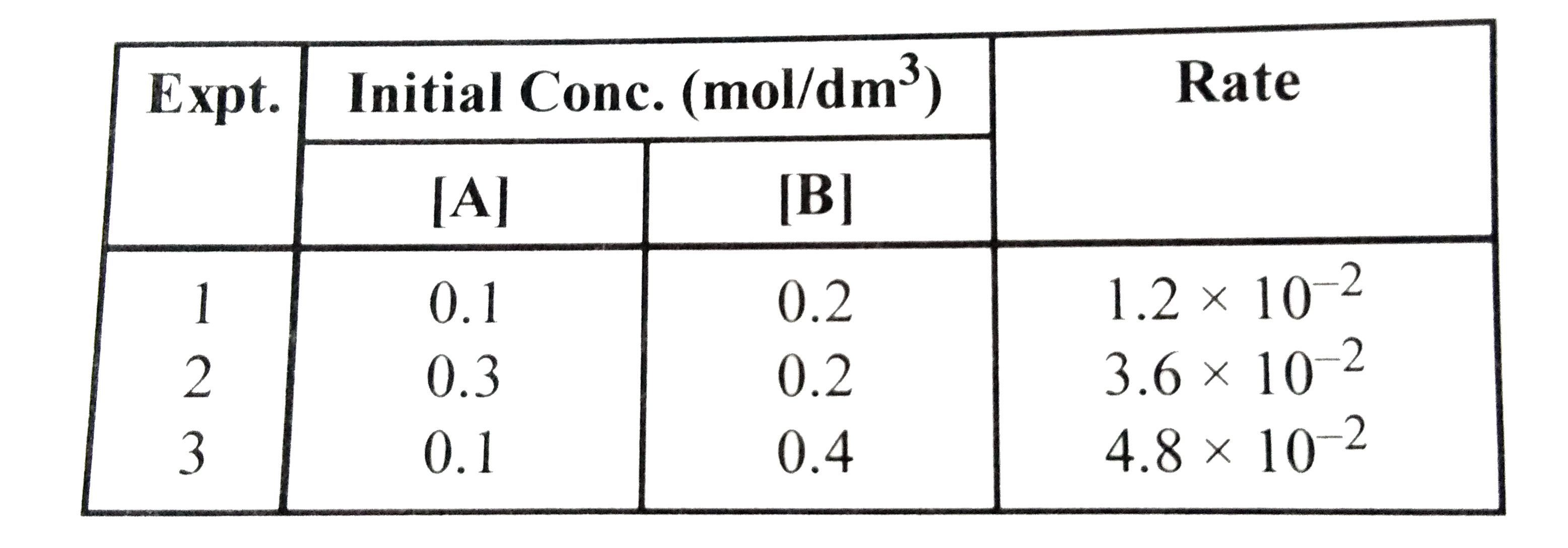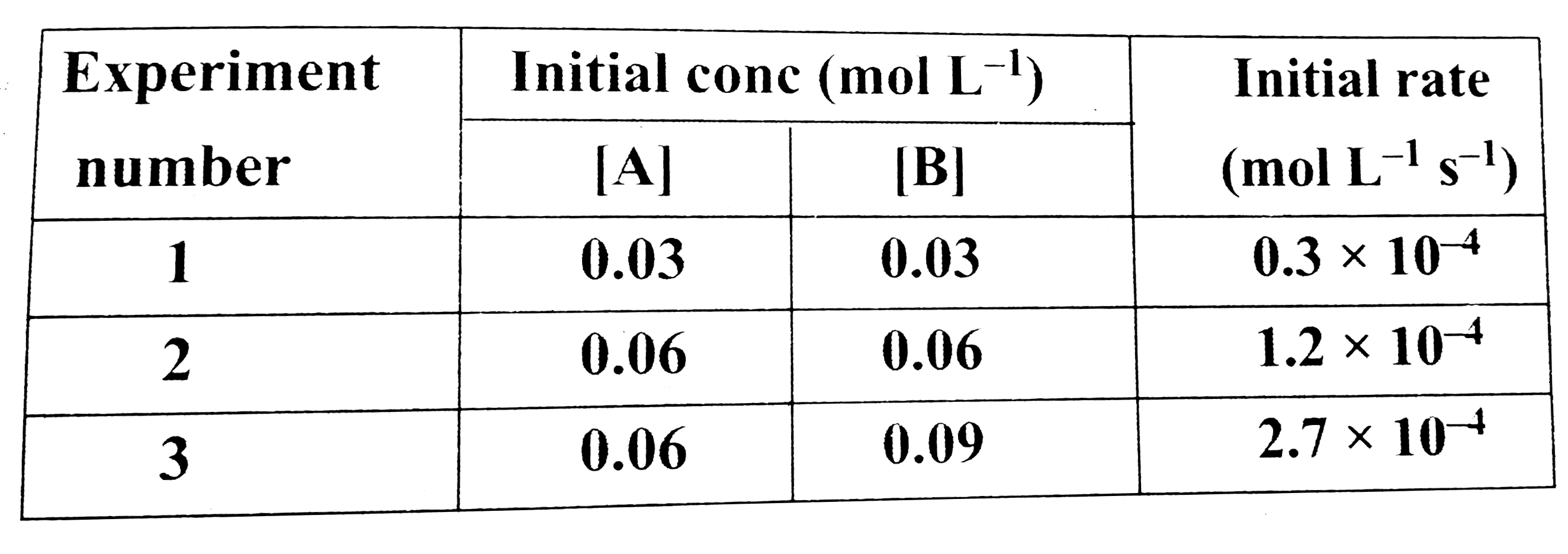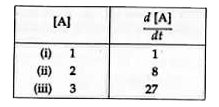For the reaction A→B+C the following data were obtained : t(s)09001800[A]50.819.77.62
Prove that the reaction is of first order . (k1 is found to be constant )
To prove that the reaction A→B+C is of first order, we will analyze the provided data and use the first-order rate equation.
1. Understanding the First-Order Reaction:
The rate equation for a first-order reaction can be expressed as:
k=2.303tlog((A)0(A))
where:
- k is the rate constant,
- t is the time,
- (A)0 is the initial concentration of A,
- (A) is the concentration of A at time t.
2. Given Data:
- At t=0 s, (A)=50.8 M
- At t=900 s, (A)=19.7 M
- At t=1800 s, (A)=7.62 M
3. Calculating k at t=900 s:
- Using the first-order equation:
k=2.303900log(50.819.7)
- Calculate 50.819.7:
50.819.7≈2.577
- Now, calculate log(2.577):
log(2.577)≈0.411
- Substitute back into the equation for k:
k≈2.303900×0.411≈0.0104(approximately)
4. Calculating k at t=1800 s:
- Using the first-order equation again:
k=2.3031800log(50.87.62)
- Calculate 50.87.62:
50.87.62≈6.66
- Now, calculate log(6.66):
log(6.66)≈0.823
- Substitute back into the equation for k:
k≈2.3031800×0.823≈0.0104(approximately)
5. Conclusion:
Since the calculated values of k at both time intervals (900 s and 1800 s) are approximately equal (both around 0.0104), we can conclude that the reaction follows first-order kinetics.
The rate equation for a first-order reaction can be expressed as:
k=2.303tlog((A)0(A))
where:
- k is the rate constant,
- t is the time,
- (A)0 is the initial concentration of A,
- (A) is the concentration of A at time t.
- At t=0 s, (A)=50.8 M
- At t=900 s, (A)=19.7 M
- At t=1800 s, (A)=7.62 M
- Using the first-order equation:
k=2.303900log(50.819.7)
- Calculate 50.819.7:
50.819.7≈2.577
- Now, calculate log(2.577):
log(2.577)≈0.411
- Substitute back into the equation for k:
k≈2.303900×0.411≈0.0104(approximately)
- Using the first-order equation again:
k=2.3031800log(50.87.62)
- Calculate 50.87.62:
50.87.62≈6.66
- Now, calculate log(6.66):
log(6.66)≈0.823
- Substitute back into the equation for k:
k≈2.3031800×0.823≈0.0104(approximately)
Since the calculated values of k at both time intervals (900 s and 1800 s) are approximately equal (both around 0.0104), we can conclude that the reaction follows first-order kinetics.
Topper's Solved these Questions
- BOOK - RC MUKHERJEECHAPTER - CHEMICAL KINETICSEXERCISE - OBJECTIVE PROBLEMS51videos
CHEMICAL KINETICS
- BOOK - RC MUKHERJEECHAPTER - CHEMICAL KINETICSEXERCISE - OBJECTIVE PROBLEMS51videos
CHEMICAL KINETICS
- BOOK - RC MUKHERJEECHAPTER - CHEMICAL EQUIVALENCEEXERCISE - PROBLEMS24videos
CHEMICAL EQUIVALENCE
- BOOK - RC MUKHERJEECHAPTER - CHEMICAL THERMODYNAMICSEXERCISE - Objective problems58videos
CHEMICAL THERMODYNAMICS
Similar Questions
In reaction, A→B+C the following data were obtained.
t in seconds0900180Concentration of A50.819.77.62
Prove that it is a first order reaction.View SolutionThe catalytic decomposition of H2O was studied by titrating it at different intervals with KMnO4 and the following data were obtained :
t (second)06001200V of KMmO4(mL)22.813.88.3
Calculate the velocity constant for the reaction assuming it to be a first order reaction.View Solution
Knowledge Check
- Question 1 - Select One
For a creactionj, the following data were obtained:

the order of reaction is:A2B1C0Dfractional - Question 2 - Select One
For the reaction between A and B
A+B→ product
the following rate data were obtained .

the reaction isAZero orderBfirst orderCsecond orderDthird order - Question 3 - Select One
For the reaction ,
Ak−−→B+C
Following data are obtained

What will be the rate of reaction (in molL−1−1min, when conc of 'A' is 3M.A2.079×10−3B6.75×10−1C7.5×10−2Dnone
For a reaction in which A and B form C, the following data were obtained form theee experiments:

What is the rate equation of the equation and what is the value of rate constant ?View SolutionFor the non-stoichiometric reaction 2A+B→C+D, The following data were obtained in three separate experiments, all at 298 K.

The rate law for the formation of C is:View Solutionform the gaseous reaction
2A+B2→2AB, the following rate data were obtained at 300K.

Calculate the rate constant for the reaction and the rate of formation of AB when [A] is 0.02 and [B2] is 0.04molL−1 at 300K.View SolutionFor the non-stoichiometric reaction:
A+B→C+D, the following kinetic data were obtained in three separate experiments, all at 298K.

The order of the reaction is.View SolutionWhat will be the order of reaction of the type A→ Product for which the following data were obtained ?
 View Solution
View Solution

